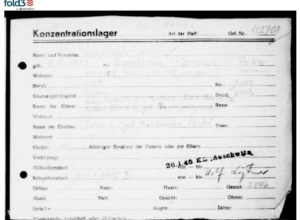
Recently, my cousin, Mel Laytner, emailed me my father’s Buchenwald Concentration Camp registration form. He found the document in the Ancestry, Jewish Gen database. I had never seen this document. If I had it would have made it into the pages of “A Hebraic Obsession”.
While faded and cut off on the bottom, I still managed to read the printed German words and some of the inked-in hand writing. And with the help of Google Translate, I understood the form’s meaning and purpose.
On the top in bold type it read: Konzentrationslager—- Concentration Camp
Date stamped in the middle of the document— 26.1.45 KL.(Konzentrationslager) Auschwitz —January 26, 1945, the date my dad left Auschwitz for Buchenwald. Directly beneath the date stamp is my father’s signature.
I studied this classic bureaucratic racial-profiling form. It focused in on the prisoner’s: size of nose, facial hair, eyes, teeth and ears.
I not surprised to see such identifiers: religion—Jude—Jew, profession, tattoos (Auschwitz prison numbers)military service, educational background, parents names and date and town of birth.
But what is extremely hard to accept is the Nazi’s pathological need to keep these detailed records. The war was almost over and Nazis knew they have lost.
I thought: “Total madness. Keep records of the people you are murdering. But records must be kept. While at the same time the evidence of your crimes must be destroyed.”
I Googled January 26, 1945 and learned of the January 26th transport. It arrived in Buchenwald the same day it left Auschwitz. It was one of the largest transports holding over 3,000 prisoners because the Russian Army would liberate the death camp on the same day.
The History Channel’s website, This Day In History reads:
The Red Army had been advancing deeper into Poland since mid-January. Having liberated Warsaw and Krakow, Soviet troops headed for Auschwitz. In anticipation of the Soviet arrival, the German Gestapo began a murder spree in the camps, shooting sick prisoners and blowing up crematoria in a desperate attempt to destroy the evidence of their crimes. When the Red Army finally broke through, Soviet soldiers encountered 648 corpses and more than 7,000 starving camp survivors. There were also six storehouses filled with literally hundreds of thousands of women’s dresses, men’s suits, and shoes that the Germans did not have time to burn.
Seventy-six days later Buchenwald was liberated. I asked, “How did my dad survive those 76 days?”
On April 11, 1945, four US soldiers arrived at the camp. “Just before the Americans had arrived, the camp had been taken over by Communist prisoners who had killed some of the guards and forced the rest to flee….
There were approximately 21,000 prisoners at Buchenwald on the day it was liberated. This included approximately 4,000 Jewish prisoners who were survivors of the death camps in what is now Poland, and 904 children under the age of 17, many of whom were orphans. See http://www.scrapbookpages.com/Buchenwald/Liberation6.html
My dad was one of the 4,000. So was Elie Wiesel.
What the readers are saying:
I got goose bumps while I read this. The more I learn about the holocaust the more deeply I feel the horror. Your father was a remarkable person and survivor. I recently bought Wiesel’s book Night and am stealing myself to read it. —Elizabeth
Remarkable information.—Elizabeth
Vey interesting.—Esther
As the mystery unravels, it just creates more questions.— Tracie
Wow! —Louis
